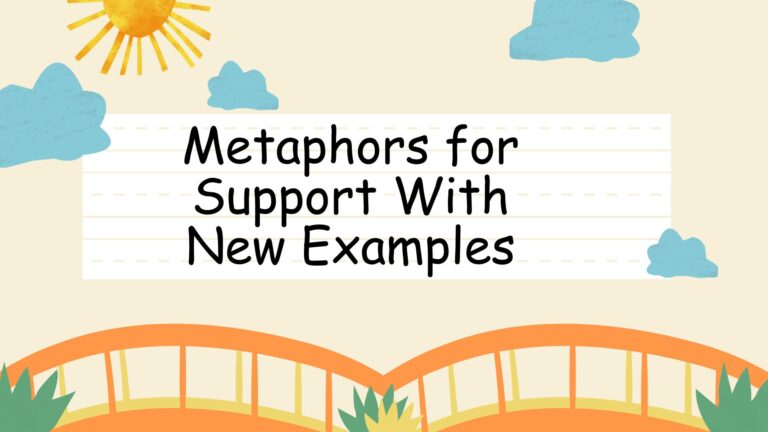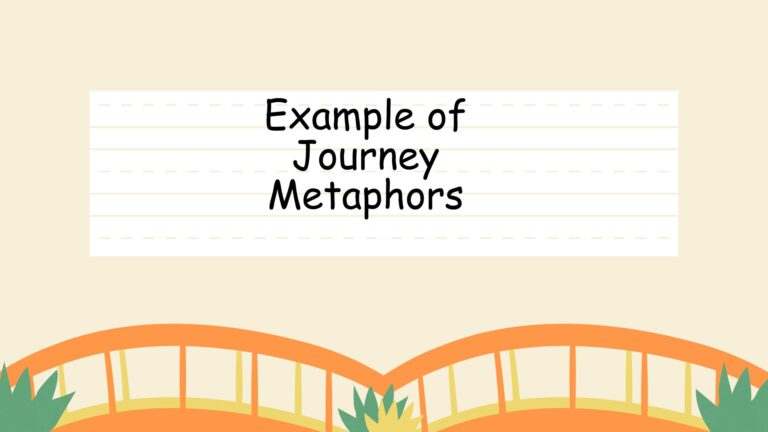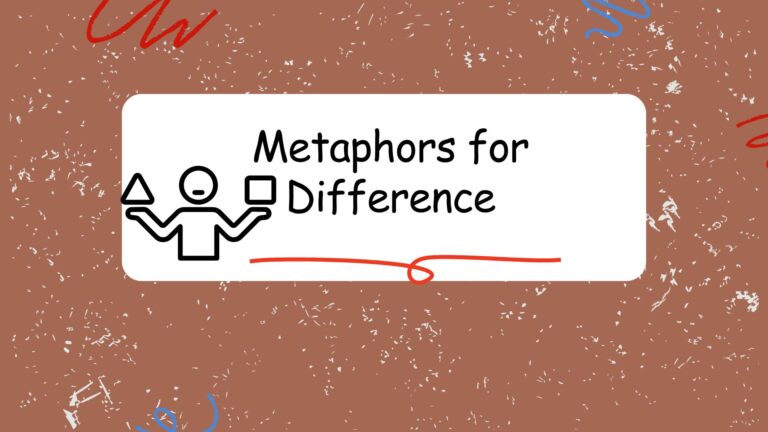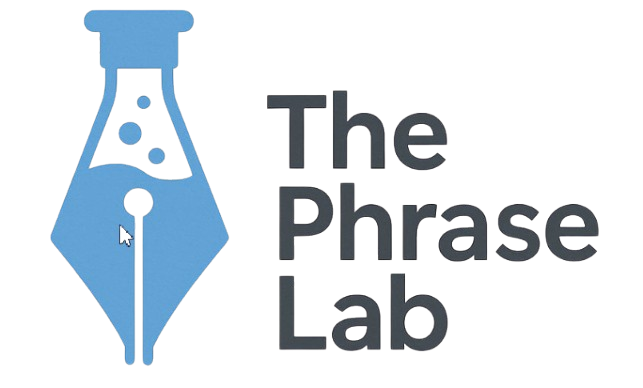
Unique Metaphors for Wave: Example and Explanation
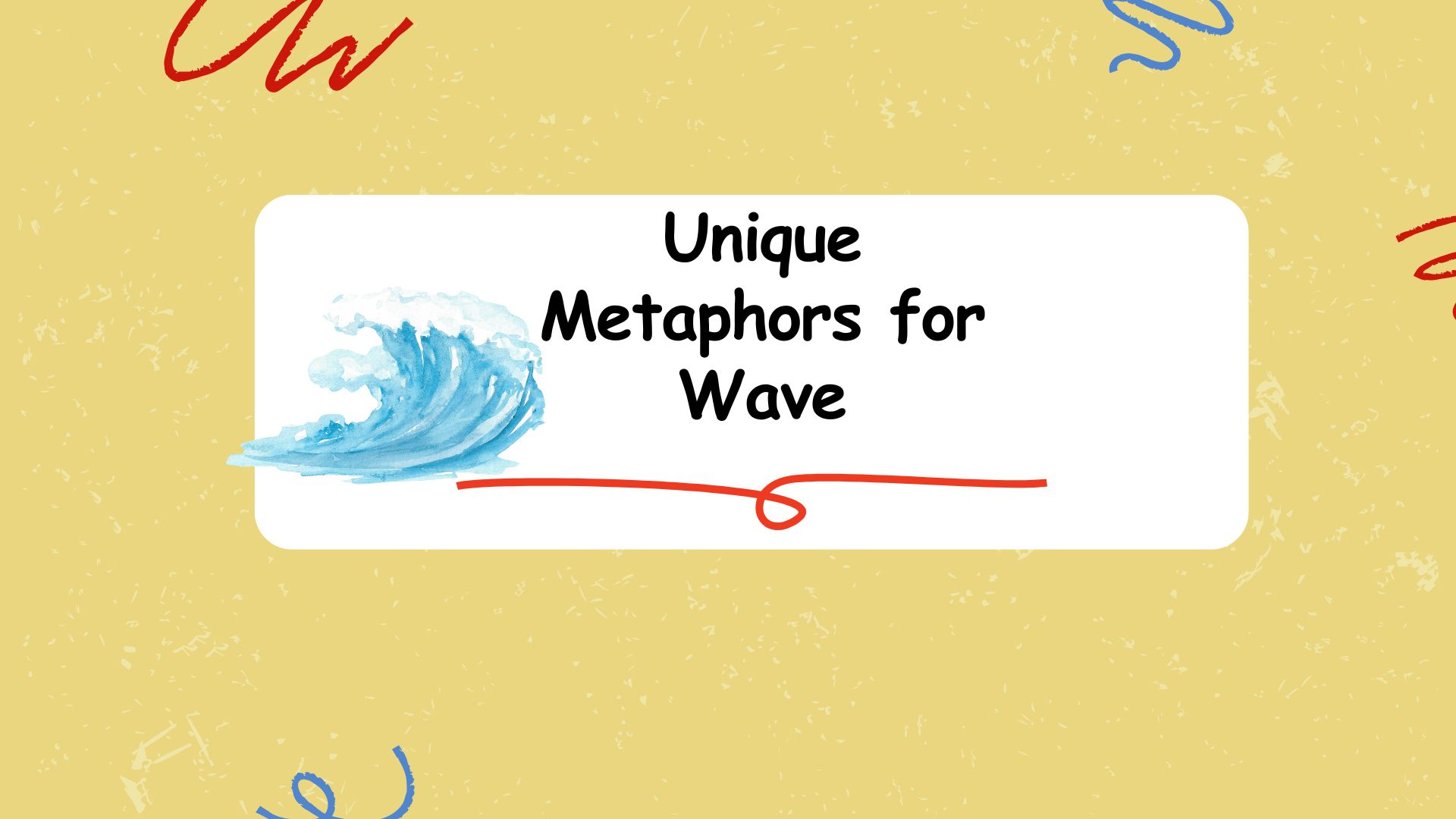
Metaphors are powerful tools in the English language, allowing us to understand abstract concepts by relating them to something more concrete. Wave metaphors, in particular, are incredibly versatile, used to describe everything from emotions and social trends to economic cycles and political movements. Understanding how these metaphors work can significantly enhance your comprehension and expression in both written and spoken English. This article will delve into the meaning, structure, and usage of wave metaphors, providing you with numerous examples and practical exercises to master this fascinating aspect of language. Whether you’re an English language learner, a student of literature, or simply someone who enjoys exploring the nuances of language, this guide will offer valuable insights and practical skills.
By the end of this article, you’ll be able to identify, interpret, and effectively use wave metaphors in various contexts. You’ll also gain a deeper appreciation for the creativity and expressiveness that metaphors bring to the English language. Let’s dive in and learn to navigate the metaphorical waves!
Table of Contents
- Introduction
- Definition of Wave Metaphors
- What is a Metaphor?
- Why Waves?
- Classification of Wave Metaphors
- Structural Breakdown
- Source Domain: Waves
- Target Domain: Abstract Concepts
- Linking Elements
- Types and Categories of Wave Metaphors
- Emotional Waves
- Social Waves
- Economic Waves
- Political Waves
- Examples of Wave Metaphors
- Emotional Wave Metaphor Examples
- Social Wave Metaphor Examples
- Economic Wave Metaphor Examples
- Political Wave Metaphor Examples
- Usage Rules for Wave Metaphors
- Appropriateness and Context
- Clarity and Precision
- Avoiding Overuse
- Common Mistakes with Wave Metaphors
- Misinterpretation of Meaning
- Inconsistent Mapping
- Practice Exercises
- Exercise 1: Identifying Wave Metaphors
- Exercise 2: Interpreting Wave Metaphors
- Exercise 3: Creating Wave Metaphors
- Advanced Topics
- Wave Metaphors in Cognitive Linguistics
- Cultural Variations in Wave Metaphors
- Frequently Asked Questions (FAQ)
- Conclusion
Definition of Wave Metaphors
Wave metaphors are a type of figurative language that uses the characteristics and behaviors of ocean waves to describe other phenomena. These metaphors draw on the natural imagery of waves – their rise and fall, their power and gentleness, their predictability and unpredictability – to convey complex ideas and emotions in a vivid and relatable way.
What is a Metaphor?
A metaphor is a figure of speech that directly compares two unlike things without using “like” or “as.” It asserts that one thing *is* another, creating a new understanding of the first thing by associating it with the second. For example, saying “He is a lion” uses the characteristics of a lion (bravery, strength) to describe a person.
Why Waves?
Waves are a particularly potent source of metaphors for several reasons. First, they are universally recognizable and easily visualized. Second, their dynamic nature – constantly moving, changing, and interacting with their environment – makes them suitable for describing processes, emotions, and trends. Third, waves can represent a wide range of qualities, from calm serenity to overwhelming force, allowing for nuanced and versatile expression.
Classification of Wave Metaphors
Wave metaphors can be classified based on the aspect of waves they emphasize:
- Amplitude: Focusing on the intensity or magnitude (e.g., “a wave of anger”).
- Frequency: Highlighting the recurrence or speed (e.g., “waves of nostalgia”).
- Direction: Indicating movement or trend (e.g., “riding the wave of popularity”).
- Impact: Emphasizing the effect or consequence (e.g., “a wave of reforms”).
- Surface Qualities: Describing the appearance or texture (e.g., “a smooth wave of optimism”).
Structural Breakdown
Understanding the structure of wave metaphors helps in both interpreting and creating them effectively. This involves identifying the source domain (waves), the target domain (the concept being described), and the linking elements that connect the two.
Source Domain: Waves
The source domain is the concrete concept that provides the metaphorical imagery. In the case of wave metaphors, the source domain is always related to waves, including their physical properties, behaviors, and associated phenomena. This includes characteristics such as:
- Crest: The highest point of a wave, representing a peak or climax.
- Trough: The lowest point of a wave, representing a low point or decline.
- Amplitude: The height of a wave, representing intensity or magnitude.
- Frequency: The number of waves per unit of time, representing recurrence or speed.
- Momentum: The force of a wave, representing power or impact.
- Rhythm: The regular pattern of waves, representing cyclical processes.
Target Domain: Abstract Concepts
The target domain is the abstract concept that is being understood through the metaphor. This can be anything from emotions and social trends to economic cycles and political movements. The effectiveness of a wave metaphor depends on how well the characteristics of waves map onto the target domain.
Linking Elements
Linking elements are the specific points of connection between the source and target domains. These are the shared characteristics or behaviors that make the metaphor meaningful. For example, if we say “a wave of sadness,” the linking element is the feeling of being overwhelmed, which is common to both the experience of being caught in a large wave and the experience of intense sadness.
Types and Categories of Wave Metaphors
Wave metaphors are used across various domains to describe diverse phenomena. Here’s a breakdown of common categories:
Emotional Waves
Emotional wave metaphors describe the intensity, duration, and cyclical nature of emotions. They often convey the sense of being overwhelmed or carried away by feelings.
Social Waves
Social wave metaphors depict trends, movements, and changes in society. They highlight the spread, impact, and eventual decline of these phenomena.
Economic Waves
Economic wave metaphors illustrate the cyclical nature of economic activity, including booms, recessions, and market fluctuations. They emphasize the ebb and flow of financial forces.
Political Waves
Political wave metaphors describe shifts in public opinion, electoral outcomes, and policy changes. They often convey the momentum and impact of political forces.
Examples of Wave Metaphors
Here are several examples of wave metaphors categorized by the domain they relate to. Each example illustrates how the characteristics of waves are used to describe different phenomena.
Emotional Wave Metaphor Examples
The following table provides examples of emotional wave metaphors, showing how waves are used to describe feelings and emotions. Each example includes a sentence and a brief explanation of the metaphor.
| Example | Explanation |
|---|---|
| A wave of grief washed over her when she heard the news. | Grief is portrayed as an overwhelming force, like a wave that engulfs someone. |
| He was caught in a wave of nostalgia, remembering his childhood. | Nostalgia is depicted as a powerful surge of memories that sweeps over someone. |
| She felt a wave of anger rising within her. | Anger is shown as building up gradually, like a wave gaining height and momentum. |
| A wave of relief swept through the crowd when the verdict was announced. | Relief is depicted as spreading quickly and widely, like a wave moving across a body of water. |
| He experienced a wave of disappointment when he didn’t get the job. | Disappointment is shown as a sudden and overwhelming feeling that hits someone. |
| Waves of sadness kept returning to her throughout the day. | Sadness is portrayed as a recurring and persistent emotion that keeps coming back. |
| She rode the wave of excitement as she prepared for her trip. | Excitement is depicted as something that can be enjoyed and navigated, like riding a wave. |
| The wave of fear paralyzed him, preventing him from acting. | Fear is shown as an immobilizing force that overwhelms someone. |
| A wave of affection surged through her as she looked at her newborn child. | Affection is depicted as a strong and powerful emotion that flows through someone. |
| He tried to suppress the wave of panic that threatened to engulf him. | Panic is shown as an overwhelming feeling that can consume someone completely. |
| A small wave of irritation flickered across her face. | Irritation is depicted as a minor and fleeting emotion. |
| The actor basked in the wave of applause after his performance. | Applause is described as a positive and overwhelming reception. |
| A wave of homesickness struck him while he was away at college. | Homesickness is shown as a sudden and intense longing for home. |
| She felt a wave of empathy for the struggling family. | Empathy is depicted as a strong and compassionate connection. |
| A wave of shame washed over him as he remembered his mistake. | Shame is portrayed as an overwhelming feeling of embarrassment. |
| He was overcome by a wave of grief after the loss. | Grief is depicted as a powerful and consuming emotion. |
| She battled against the wave of depression. | Depression is shown as a persistent and difficult force to overcome. |
| A wave of excitement bubbled up inside her. | Excitement is portrayed as a feeling that builds gradually. |
| He was swept away by a wave of love. | Love is depicted as a powerful and overwhelming emotion. |
| A wave of fatigue crashed over her after the long day. | Fatigue is shown as an overwhelming feeling of tiredness. |
| She braced herself against the oncoming wave of despair. | Despair is depicted as an inevitable and powerful emotion. |
| A sudden wave of gratitude overwhelmed him. | Gratitude is shown as a strong and heartfelt emotion. |
| He tried to navigate the turbulent waves of his emotions. | Emotions are depicted as unpredictable and challenging. |
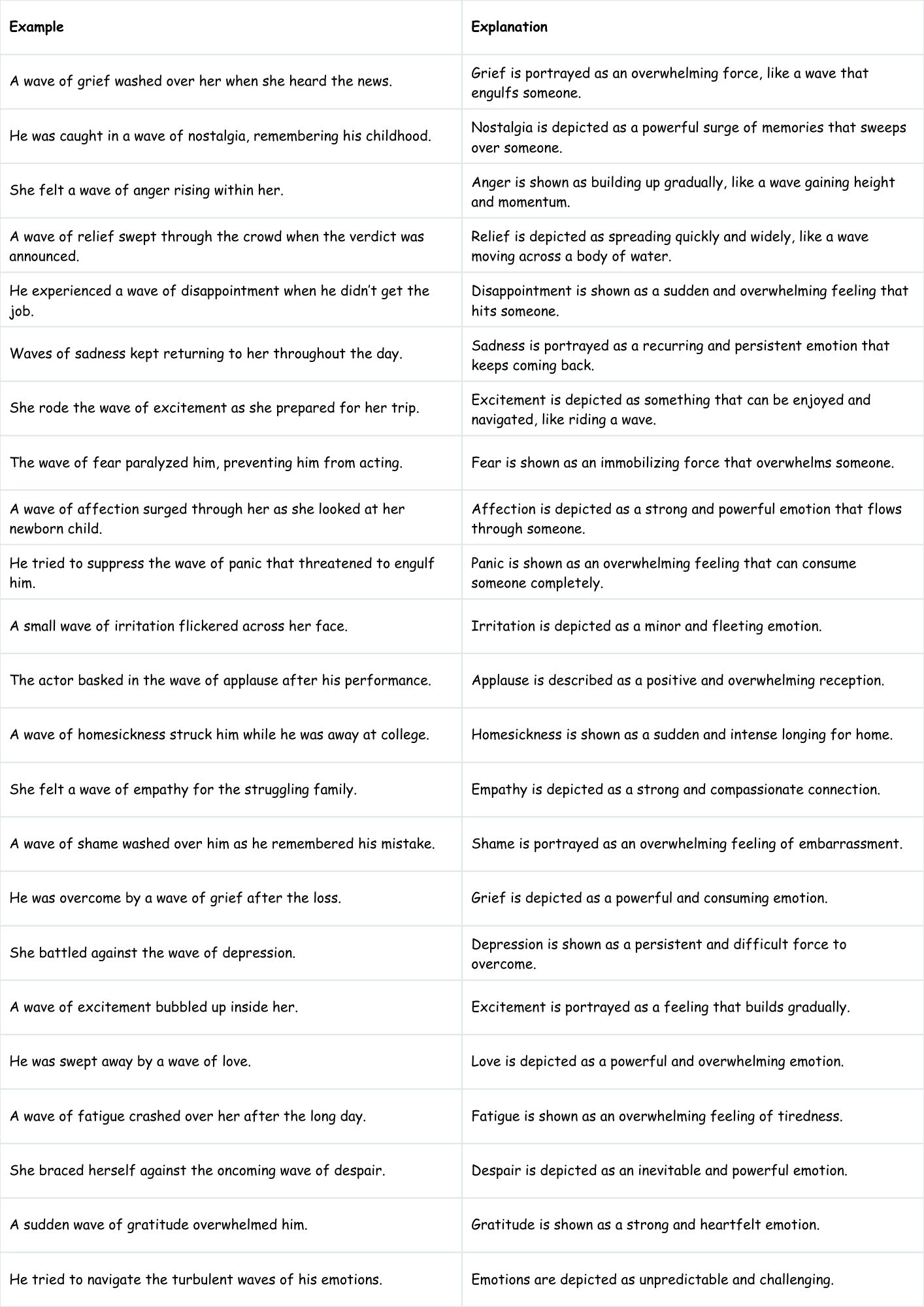
Social Wave Metaphor Examples
The following table provides examples of social wave metaphors, showing how waves are used to describe trends and societal changes. Each example includes a sentence and a brief explanation of the metaphor.
| Example | Explanation |
|---|---|
| The country experienced a wave of immigration in the early 20th century. | Immigration is portrayed as a large-scale movement of people, like a wave flowing into a new area. |
| A wave of protests swept across the nation. | Protests are depicted as spreading rapidly and widely, like a wave moving across a landscape. |
| The city is riding a wave of gentrification, with new businesses and residents moving in. | Gentrification is shown as a trend that is currently in progress and gaining momentum. |
| There’s a growing wave of support for environmental policies. | Support for environmental policies is depicted as increasing in strength and popularity. |
| The company capitalized on the wave of interest in sustainable products. | Interest in sustainable products is shown as a trend that can be taken advantage of. |
| A wave of technological innovation is transforming the industry. | Technological innovation is portrayed as a powerful force that is reshaping the industry. |
| The school is experiencing a wave of new enrollments. | New enrollments are depicted as a sudden increase in numbers. |
| A wave of nostalgia for the 1980s is sweeping popular culture. | Nostalgia is shown as a trend that is becoming increasingly prevalent. |
| The community is fighting against a wave of crime. | Crime is depicted as a negative trend that needs to be combated. |
| A wave of volunteerism emerged after the natural disaster. | Volunteerism is shown as a spontaneous and widespread response to a crisis. |
| The country is experiencing a wave of economic growth. | Economic growth is depicted as a positive trend. |
| A wave of fashion trends from the past is resurfacing. | Fashion trends are shown as cyclical. |
| The company is adapting to the wave of digital transformation. | Digital transformation is depicted as an inevitable change. |
| The city is bracing for a wave of tourists. | Tourists are depicted as a large influx. |
| A wave of criticism followed the controversial decision. | Criticism is shown as a widespread negative reaction. |
| The movement started as a small ripple but grew into a wave. | The movement is depicted as gaining momentum over time. |
| The industry is navigating a wave of regulatory changes. | Regulatory changes are shown as a challenge. |
| A wave of creativity is sweeping through the art scene. | Creativity is depicted as a vibrant trend. |
| The company is riding the wave of social media marketing. | Social media marketing is shown as a current trend. |
| A wave of health consciousness is influencing consumer choices. | Health consciousness is depicted as a growing trend. |
| The city is struggling with a wave of unemployment. | Unemployment is shown as a significant problem. |
| A wave of innovation is driving the technology sector. | Innovation is depicted as a powerful force. |
| The community is uniting against a wave of discrimination. | Discrimination is shown as a negative force being combated. |
| A wave of awareness about mental health is spreading. | Awareness is depicted as a positive change. |
Economic Wave Metaphor Examples
The following table provides examples of economic wave metaphors, showing how waves are used to describe market trends and financial changes. Each example includes a sentence and a brief explanation of the metaphor.
| Example | Explanation |
|---|---|
| The economy is experiencing a wave of inflation. | Inflation is depicted as a rising economic trend. |
| The stock market is riding a wave of bullish sentiment. | Bullish sentiment is shown as driving the market upwards. |
| The company is weathering a wave of economic downturn. | Economic downturn is depicted as a challenging period. |
| A wave of investment is flowing into renewable energy. | Investment is shown as a significant influx of capital. |
| The housing market is experiencing a wave of price increases. | Price increases are depicted as a rising trend. |
| The company is trying to ride the wave of e-commerce growth. | E-commerce growth is shown as an opportunity to be capitalized on. |
| The market is bracing for a wave of interest rate hikes. | Interest rate hikes are depicted as an impending challenge. |
| A wave of bankruptcies swept through the industry. | Bankruptcies are shown as a widespread negative trend. |
| The company is benefitting from a wave of consumer spending. | Consumer spending is depicted as a positive economic driver. |
| The economy is struggling with a wave of unemployment claims. | Unemployment claims are shown as a significant economic challenge. |
| A wave of mergers and acquisitions is reshaping the corporate landscape. | Mergers and acquisitions are shown as a transformative force. |
| The market is experiencing a wave of volatility. | Volatility is depicted as a period of instability. |
| A wave of technological disruption is affecting traditional industries. | Technological disruption is shown as a major challenge. |
| The company is navigating a wave of supply chain disruptions. | Supply chain disruptions are depicted as a difficult issue. |
| A wave of automation is transforming the manufacturing sector. | Automation is shown as a major trend. |
| The economy is facing a wave of debt defaults. | Debt defaults are depicted as a significant problem. |
| A wave of new startups is entering the market. | New startups are shown as increasing competition. |
| The market is responding to a wave of regulatory changes. | Regulatory changes are depicted as influencing market behavior. |
| A wave of globalization is connecting economies worldwide. | Globalization is shown as a force for interconnectedness. |
| The company is adapting to a wave of changing consumer preferences. | Changing consumer preferences are depicted as a challenge. |
| A wave of cybersecurity threats is impacting businesses. | Cybersecurity threats are shown as a significant risk. |
| The market is reacting to a wave of geopolitical instability. | Geopolitical instability is depicted as causing market uncertainty. |
| A wave of sustainable investing is influencing financial decisions. | Sustainable investing is shown as a growing trend. |
Political Wave Metaphor Examples
The following table provides examples of political wave metaphors, showing how waves are used to describe political trends and changes. Each example includes a sentence and a brief explanation of the metaphor.
| Example | Explanation |
|---|---|
| A wave of populism is sweeping across Europe. | Populism is depicted as a rising political trend. |
| The election resulted in a wave of new representatives in Congress. | New representatives are shown as a significant change in the political landscape. |
| The country is experiencing a wave of political reform. | Political reform is depicted as a period of change. |
| A wave of protests challenged the government’s policies. | Protests are shown as a widespread challenge to authority. |
| The politician is riding a wave of popularity. | Popularity is depicted as supporting the politician’s success. |
| A wave of conservative ideology is influencing policy decisions. | Conservative ideology is shown as a dominant political trend. |
| The country is bracing for a wave of political unrest. | Political unrest is depicted as an impending challenge. |
| A wave of corruption scandals has shaken the government. | Corruption scandals are shown as a destabilizing force. |
| The new law faced a wave of opposition from civil rights groups. | Opposition is depicted as a widespread challenge. |
| A wave of nationalism is affecting international relations. | Nationalism is shown as a significant political trend. |
| The political landscape is experiencing a wave of realignment. | Realignment is depicted as a major shift in alliances. |
| A wave of democratic movements is spreading across the region. | Democratic movements are shown as a positive trend. |
| The government is facing a wave of public discontent. | Public discontent is depicted as a significant challenge. |
| A wave of extremism is threatening social stability. | Extremism is shown as a dangerous force. |
| The political party is riding a wave of grassroots support. | Grassroots support is depicted as a key factor in their success. |
| A wave of protectionist policies is impacting global trade. | Protectionist policies are shown as a significant trend. |
| The country is struggling with a wave of political polarization. | Political polarization is depicted as a major challenge. |
| A wave of social justice activism is influencing political discourse. | Social justice activism is shown as a force for change. |
| The government is responding to a wave of immigration concerns. | Immigration concerns are depicted as a significant issue. |
| A wave of environmental activism is shaping policy agendas. | Environmental activism is shown as a political influence. |
| The politician is trying to stem the wave of negative publicity. | Negative publicity is depicted as a damaging force. |
| A wave of electoral reforms is aiming to improve democracy. | Electoral reforms are shown as a positive development. |
| The government is navigating a wave of international criticism. | International criticism is depicted as a challenging issue. |
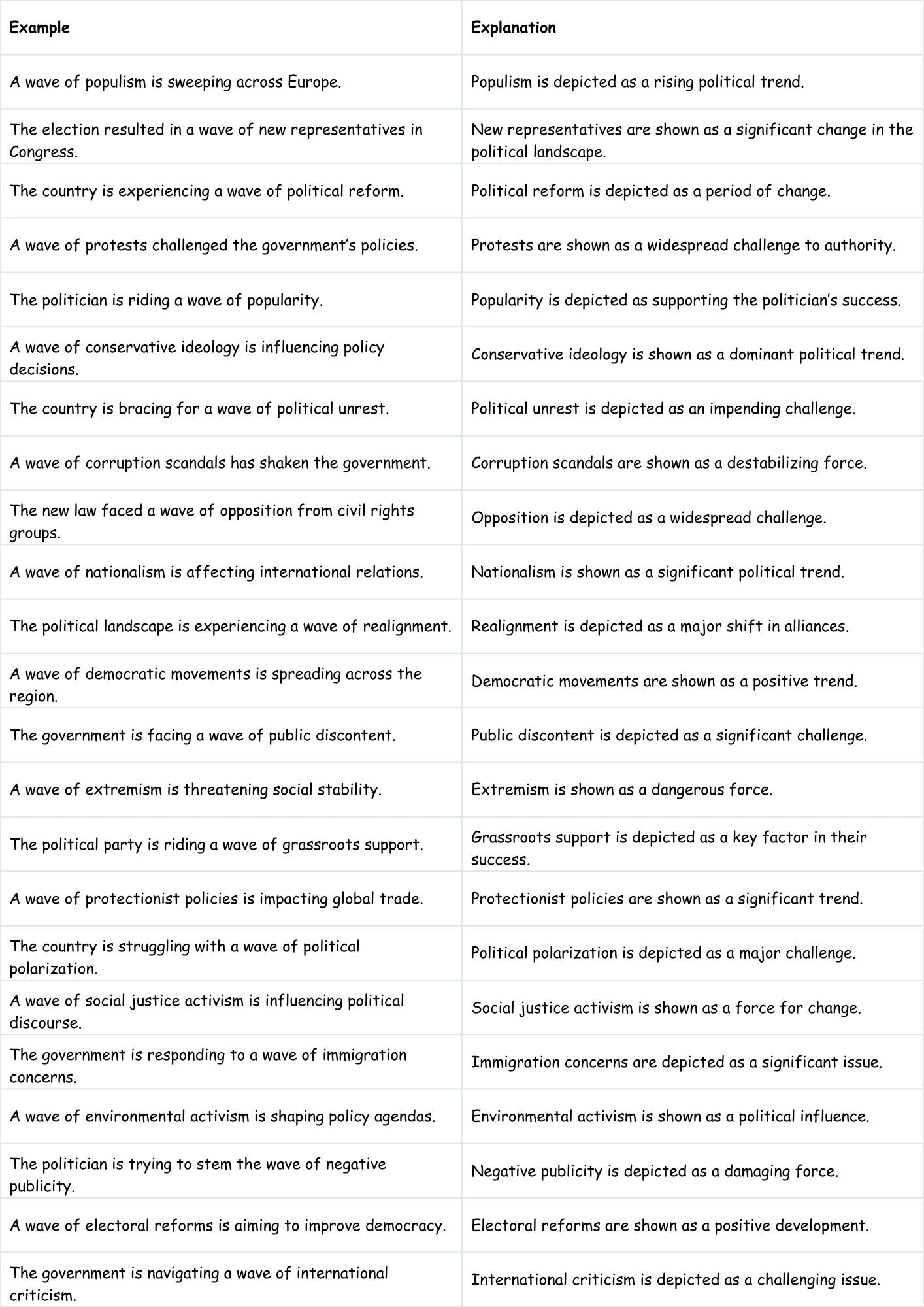
Usage Rules for Wave Metaphors
To use wave metaphors effectively, it’s important to follow certain guidelines. These rules ensure that your metaphors are clear, appropriate, and impactful.
Appropriateness and Context
Consider the context and audience when using wave metaphors. Ensure that the metaphor is relevant and understandable to your audience. Avoid using overly complex or obscure metaphors that may confuse or alienate your readers or listeners. The tone of the metaphor should also align with the overall tone of your communication.
Clarity and Precision
Make sure the connection between the wave imagery and the target concept is clear. The metaphor should enhance understanding, not obscure it. Use precise language to establish the linking elements between the source and target domains. If the connection is too vague or ambiguous, the metaphor will lose its impact.
Avoiding Overuse
While wave metaphors can be powerful, overuse can diminish their impact. Use them sparingly and strategically to emphasize key points. Too many metaphors in a short space can make your writing or speech sound cluttered and less effective. Vary your figurative language to maintain interest and clarity.
Common Mistakes with Wave Metaphors
Even experienced writers and speakers can make mistakes when using wave metaphors. Here are some common pitfalls to avoid.
Misinterpretation of Meaning
One common mistake is using a wave metaphor in a way that could be easily misinterpreted. This can happen if the metaphor is too abstract or if the linking elements are not clearly established. Always consider how your audience might interpret the metaphor and adjust your language accordingly.
Incorrect: The project is facing a wave of sunshine.
Correct: The project is experiencing a wave of optimism.
Inconsistent Mapping
Another mistake is creating a metaphor with inconsistent mapping between the source and target domains. This means that the characteristics of waves don’t logically align with the concept you’re trying to describe. Such inconsistencies can lead to confusion and undermine the effectiveness of the metaphor.
Incorrect: The company is drowning in a wave of profits.
Correct: The company is swimming in a wave of profits.
Practice Exercises
Test your understanding of wave metaphors with these exercises.
Exercise 1: Identifying Wave Metaphors
Identify the wave metaphors in the following sentences and explain what concept is being described.
| Question | Answer |
|---|---|
| 1. A wave of sadness washed over her as she remembered her lost friend. | Wave metaphor: “wave of sadness.” Concept: Grief or sorrow. |
| 2. The country is riding a wave of economic prosperity. | Wave metaphor: “wave of economic prosperity.” Concept: Economic growth. |
| 3. A wave of protests swept through the city. | Wave metaphor: “wave of protests.” Concept: Social unrest. |
| 4. The politician is facing a wave of criticism after his controversial statement. | Wave metaphor: “wave of criticism.” Concept: Public disapproval. |
| 5. A wave of nostalgia swept over him as he looked through old photographs. | Wave metaphor: “wave of nostalgia.” Concept: Fond memories. |
| 6. The industry is dealing with a wave of technological disruption. | Wave metaphor: “wave of technological disruption.” Concept: Rapid technological change. |
| 7. A wave of relief washed over the rescue workers when they found the missing child. | Wave metaphor: “wave of relief.” Concept: Alleviation of stress. |
| 8. The company is trying to ride the wave of social media marketing. | Wave metaphor: “ride the wave of social media marketing.” Concept: Taking advantage of a popular trend. |
| 9. A wave of homesickness hit her while she was traveling abroad. | Wave metaphor: “wave of homesickness.” Concept: Longing for home. |
| 10. The market is bracing for a wave of interest rate hikes. | Wave metaphor: “wave of interest rate hikes.” Concept: Anticipated financial changes. |
Exercise 2: Interpreting Wave Metaphors
Explain the meaning of the following wave metaphors in your own words.
| Question | Answer |
|---|---|
| 1. “The scandal created a wave of outrage among the public.” | The scandal caused widespread anger and strong disapproval from the public. |
| 2. “The new product is riding a wave of popularity.” | The new product is currently very popular and successful. |
| 3. “The company is weathering a wave of economic uncertainty.” | The company is facing a challenging period of economic instability. |
| 4. “The movement started as a small ripple but grew into a wave.” | The movement began with little impact but gradually gained momentum and influence. |
| 5. “The government is trying to stem the wave of illegal immigration.” | The government is attempting to control or reduce the flow of illegal immigration. |
| 6. “A wave of innovation is transforming the industry.” | The industry is undergoing significant changes due to new and advanced technologies. |
| 7. “The actor basked in the wave of applause after his stellar performance.” | The actor enjoyed the overwhelming positive reception and appreciation from the audience. |
| 8. “The city is preparing for a wave of tourists during the summer months.” | The city is expecting a large influx of tourists during the summer. |
| 9. “A wave of health consciousness is influencing consumer choices.” | People are increasingly making purchasing decisions based on health considerations. |
| 10. “The political party is riding a wave of grassroots support.” | The political party is experiencing strong support from ordinary citizens and local communities. |
Exercise 3: Creating Wave Metaphors
Create your own wave metaphors to describe the following concepts.
| Concept | Your Wave Metaphor |
|---|---|
| 1. A sudden realization | A wave of understanding crashed over her. |
| 2. A period of rapid growth | The city experienced a wave of urban expansion. |
| 3. Overwhelming joy | A wave of pure joy flooded his heart. |
| 4. A significant political shift | A wave of change swept through the government. |
| 5. A surge in creativity | A wave of artistic inspiration washed over her. |
| 6. A period of intense pressure | The team faced a wave of unrelenting demands. |
| 7. A sudden feeling of loneliness | A wave of solitude enveloped him in the empty house. |
| 8. An increase in public interest | A wave of curiosity sparked after the documentary aired. |
| 9. A period of financial instability | The market weathered a wave of economic turbulence. |
| 10. A strong desire to travel | A wave of wanderlust overcame her. |
Advanced Topics
For those interested in a deeper understanding of wave metaphors, here are some advanced topics to explore.
Wave Metaphors in Cognitive Linguistics
Cognitive linguistics explores how metaphors shape our understanding of the world. Wave metaphors, in particular, reveal how we use concrete experiences (like observing ocean waves) to conceptualize abstract ideas. This field examines the underlying cognitive processes that enable us to make these metaphorical connections and how these connections influence our thinking and behavior.
Cultural Variations in Wave Metaphors
While the basic imagery of waves is universal, the specific ways in which wave metaphors are used can vary across cultures. Different cultures may emphasize different aspects of waves or associate them with different meanings. Exploring these cultural variations can provide valuable insights into the diverse ways people perceive and express their experiences.
Frequently Asked Questions (FAQ)
Here are some common questions about wave metaphors.
- What is the difference between a metaphor and a simile?A metaphor directly equates two unlike things (e.g., “He is a lion”), while a simile compares them using “like” or “as” (e.g., “He is as brave as a lion”). Metaphors are more assertive and create a stronger sense of connection.
- Why are wave metaphors so commonly used?Wave metaphors are common because waves are a universally recognizable and relatable phenomenon. Their dynamic nature makes them suitable for describing processes, emotions, and trends in a vivid and accessible way.
- Can a wave metaphor be extended?Yes, a wave metaphor can be extended by elaborating on the wave imagery and drawing multiple connections between the source and target domains. However, it’s important to maintain consistency and avoid stretching the metaphor too far, which can lead to confusion.
- How do I create effective wave metaphors?To create effective wave metaphors, start by identifying the key characteristics of the concept you want to describe. Then, think about how these characteristics relate to the properties and behaviors of waves. Use precise language to establish the linking elements between the two.
- What are some alternatives to wave metaphors?Alternatives to wave metaphors include other types of natural imagery (e.g., storms, mountains, rivers), as well as metaphors based on human experiences (e.g., journeys, battles, games). The best alternative will depend on the specific concept you want to describe and the
audience you are trying to reach.
Conclusion
Wave metaphors are a powerful and versatile tool for expressing complex ideas and emotions. By understanding the structure, types, and usage rules of these metaphors, you can enhance your communication skills and gain a deeper appreciation for the nuances of the English language. Whether you’re analyzing literature, writing a speech, or simply trying to express yourself more effectively, mastering wave metaphors will undoubtedly enrich your linguistic toolkit. So go ahead, ride the wave of metaphorical expression and discover the power of language!

